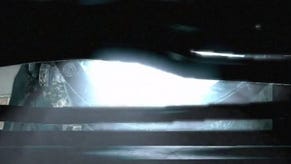Is it possible to run The Evil Within on PC at a locked 1080p60?
Not even an overclocked i7 and the fastest GPU on the planet can manage it.
Bethesda has given PC users the tools to unlock The Evil Within's built-in 30fps cap, but we couldn't help but wonder - just how much computational power is required to double the game's frame-rate and produce a sustained, consistent 60fps experience at 1080p? It turns out that our PC test rig - fitted with a Core i7 3770K overclocked to 4.3GHz and matched with 16GB of DDR3 - couldn't handle it, not even when outfitted with the GeForce GTX 980, the fastest single-chip graphics card available on the market today.
What's curious is that despite The Evil Within's apparently mammoth system requirements for the best experience, what looks like a straight, under-optimised PC conversion works fairly well with entry-level enthusiast hardware. As we've seen in the past, a hard 30fps lock can give both CPU and GPU a lot of "wiggle room" - and in the case of The Evil Within, a lowly Core i3 4130 paired with a £100 GTX 750 Ti produces an experience very close indeed to the PS4 version. The problem is scalability - while it's relatively straightforward to maintain 30fps at higher resolutions with a good enthusiast card, locking to 60fps at 1080p just wasn't possible on any of the hardware configurations we tested.
In the video below, you'll find a broad overview of the components we tested and the results gained. In addition to the GTX 750 Ti, 760 and 980, we've also played the game on other enthusiast-level top-line GPUs, including the GTX 780 and the AMD Radeon R9 290X - and unfortunately none of them sustain anything approaching a flawlessly smooth 1080p60 update.
Right now, resolution seems to be the only dimension in scalability available - certainly in terms of quality presets, there's nothing here that significantly moves image quality beyond PlayStation 4 standard. And that's a real shame. There are three anti-aliasing settings - FXAA, MLAA and SMAA - but none of them do a particularly good job in tackling the myriad aliasing issues the game features. Forcing multi-sampling (MSAA) via the GPU control panel also fails to refine image quality to any noticeable extent, while Nvidia's built-in super-sampling technology - DSR - also seems non-functional on this particular title.
Bethesda has warned of issues in utilising the built-in tools that allow PC users to dabble with the technical set-up of the game, but has made noises about getting the game to run at 60fps. Based on what we've been playing over the last couple of days, that is looking like a gargantuan optimisation effort. In the here and now, The Evil Within joins the ranks of a steadily growing number of disappointing PC conversions, where achieving console-style image quality and performance is relatively straightforward on mid-range gaming PCs, but scaling up beyond the 30fps console standard to a locked 60fps proves inordinately difficult.
In the case of The Evil Within, it's a little strange, bearing in mind that the id Tech 5 engine on which it is based was designed by John Carmack and his colleagues with 60fps gameplay in mind - to the point where Jens Matthies, Creative Director at Machine Games noted that the technology effectively forced them into running Wolfenstein: The New Order at 60fps.
What's clear is that the engine has been dramatically altered for this new game - The Evil Within's lighting system is quite unlike any other id Tech 5 title's - but regardless, the performance bottlenecks we encountered in the PC version are deeply disappointing. Our tests here continue, and we hope to post our full Xbox One/PS4/PC comparison in the next couple of days.










